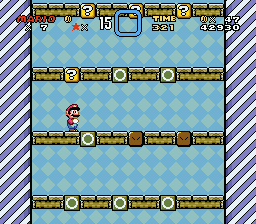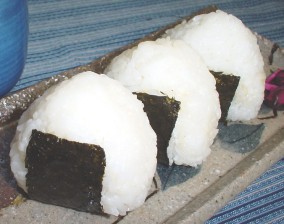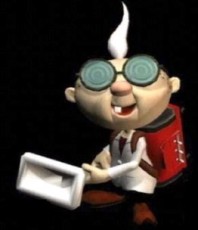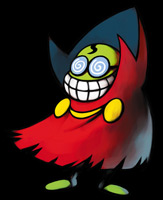Mario games, like many others, are almost always released in Japan first. The programmers and game designers often base characters and events after their personal experiences, inside jokes, and sometimes even Japanese and American stories and fables. The finished game leaves many interesting things, which become more interesting the deeper you dive into it. Some things go unnoticed, while others leave you scratching your head. For example, "Who is Kuribo?", or "Since when is she 'Peach'?!". Read on, and this page might answer some of your unanswered questions.
Familiar names
Princess Toadstool has always been "Princess Peach" in Japan. The first game in America to use "Peach" was Yoshi's Safari, but the most noticed instance was in Super Mario 64, released three years after Yoshi's Safari.
Goombas are known as "Kuribō" in Japan. Kuri means "chestnut," and bō could mean "people" (bō has a lot of meanings).
Bowser is always "Kuppa" (pronounced: Koopa) in Japan. Mario creator Shigeru Miyamoto revealed in an interview with Famitsu magazine that they considered naming Mario's nemesis either Kuppa (gukbap), Yukke (yukhoe), or Bibinba (bibimbap), all Korean dishes.
Toad's Japanese name is "Kinopio," which comes from kinoko (mushroom).
Hinopio from Super Mario RPG is a play on Kinopio (Toad's Japanese name) and hi (Japanese for "fire").
Waluigi: Nintendo Power magazine Vol. 135 (August 2000 issue) enlightened us with the fact that Waluigi's name "comes from a rearrangement of the word [ijiwaru]—Japanese for 'someone who's bad.'"
Wario's name is a combination of Mario and warui, which means "bad" in Japanese.
NokNok Shell (from Super Mario RPG) and Nokobon (from Super Mario Land) both come from "Noko Noko," the Japanese name for Koopa Troopas. Incidentally, the Japanese word nokonoko means "unconcernedly."
Kamek, the Magikoopa, is not just a clever name. Kame is the Japanese word for turtle.
For explanations of Tanooki Mario, Jugem's Cloud, and Kuribo's Shoe, refer to the Super Mario Bros. 3: From Japanese to English page.
From Japanese to English
Most Nintendo-published games are developed in Japan. Then, before coming to North America, the games' text and manuals are painstakingly translated into English. When the localized versions are finally released, sometimes more than the language has changed! Click a game title below to see differences between the U.S. and Japanese versions of the game. We'll also point out the character and item name changes, and any Japanese influences wherever they pop up.
- Donkey Kong - NES / Famicom
- Donkey Kong Country - Super NES
- Dr. Mario 64 - Nintendo 64 / GameCube
- Luigi's Mansion - GameCube
- Mario & Luigi: Bowser's Inside Story - Nintendo DS
- Mario & Luigi: Partners in Time - Nintendo DS
- Mario & Luigi: Superstar Saga - Game Boy Advance
- Mario Bros. - NES / Famicom
- Mario Golf - Nintendo 64
- Mario Kart 64 - Nintendo 64
- Mario Kart DS - Nintendo DS
- Mario Kart Tour - iOS
- Mario Kart: Double Dash!! - GameCube
- Mario Kart: Super Circuit - Game Boy Advance
- Mario Party Advance - Game Boy Advance
- Mario Pinball Land - Game Boy Advance
- New Super Mario Bros. - Nintendo DS
- Paper Mario - Nintendo 64
- Paper Mario: The Thousand-Year Door - GameCube
- Super Mario 3D Land - Nintendo 3DS
- Super Mario 64 - Nintendo 64
- Super Mario 64 DS - Nintendo DS
- Super Mario All-Stars - Super NES / Super Famicom
- Super Mario Bros. - NES / Famicom
- Super Mario Bros. 2 (USA) - NES / Famicom
- Super Mario Bros. 3 - NES / Famicom
- Super Mario Bros. Deluxe - Game Boy Color
- Super Mario Galaxy - GameCube
- Super Mario Kart - Super NES / Super Famicom
- Super Mario Land - Game Boy
- Super Mario Land 2: 6 Golden Coins - Game Boy
- Super Mario RPG: Legend of the Seven Stars - Super NES / Super Famicom
- Super Mario Run - iOS
- Super Mario Sunshine - GameCube
- Super Mario World - Super NES / Super Famicom
- Super Mario World 2: Yoshi's Island - Super NES / Super Famicom
- Super Princess Peach - Nintendo DS
- Super Smash Bros. Brawl - Wii
- Super Smash Bros. Melee - GameCube
- Wario Land: Shake It! - Wii
- Wario Land: Super Mario Land 3 - Game Boy
- Wario's Woods - NES / Famicom
- Yoshi's Safari - Super NES / Super Famicom
Note: We use the modified Hepburn romanization system in our Japanese to English articles.
O's and X's
While playing a video game, you may see a circle used to indicate that you did something correctly, or an "X" to indicate failure. In Japan, a small circle is generally used instead of a check mark as a symbol for "yes" or "correct." Mario games that have used this include Mario & Luigi: Bowser's Inside Story, Mario & Luigi: Partners in Time, Super Mario World, Paper Mario, Paper Mario: The Thousand-Year Door, and Yoshi Topsy-Turvy.

Onigiri
The onigiri, a hand-rolled sushi snack, has snuck into a few Mario games. A triangular onigiri appears as a character in Wrecking Crew '98 and as one of many food items in Super Smash Bros. Melee.

Swirly glasses
In Japanese animation (anime), keep an eye out for glasses with swirly lenses. The swirls mean that the lenses are quite thick, and this implies that the wearer is nerdy. Mario characters with swirly glasses include Professor E. Gadd, Fawful, and Professor Frankly (from Paper Mario: The Thousand-Year Door).



Japan-only Mario games
Some Mario games were not released in North America. For some reason, most of them are puzzle games. Nintendo probably thought these games would not sell well in America, and to release them would be a waste of time and money. The Japanese version of Super Mario Bros. 2 arrived in America about seven years later (as part of Super Mario All-Stars) because Nintendo thought the game was too challenging. For a list of Japan-only Mario games, please see the Games section.